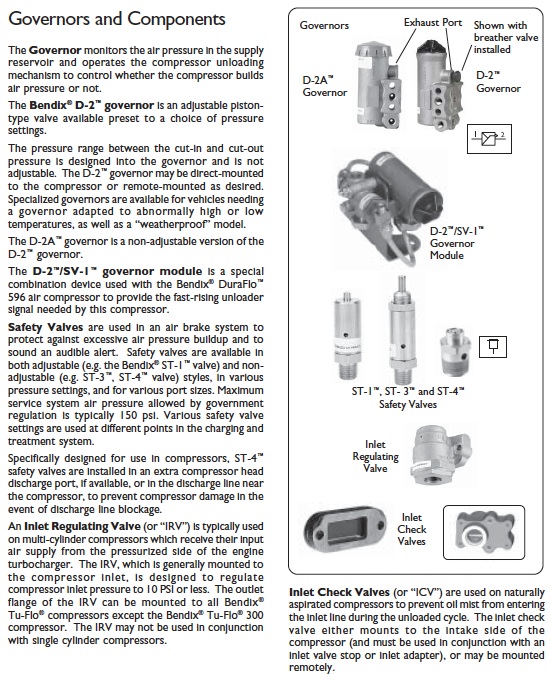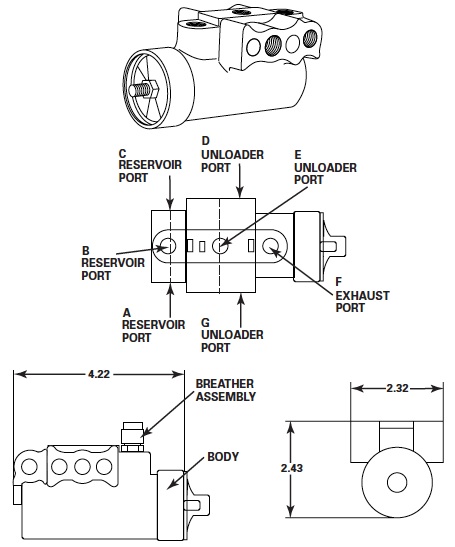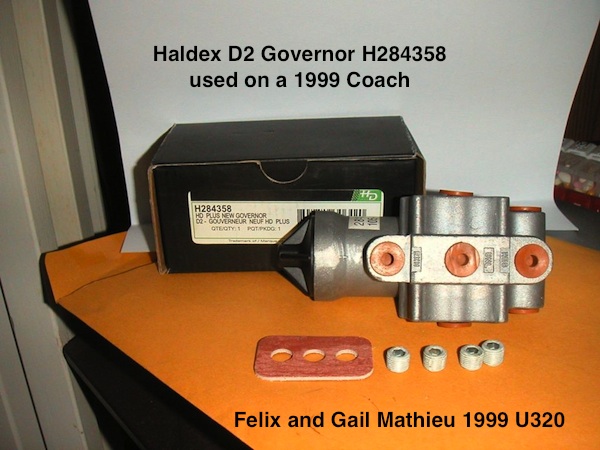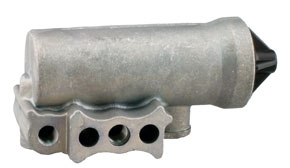Air compressors are designed to run whenever the engine is running. As a result, they are able to produce much more air than is needed by the brake system. To prevent the compressor from producing too much-compressed air and to reduce the load on the engine, a governor is used in the air brake system. When air pressure is high enough in the system, the governor causes the compressor to stop pumping air (cut-out). When the air pressure drops to a certain point, the governor will cause the compressor to start pumping air again (cut-in).

Meritor
- Operates in conjunction with the compressor unloading mechanism.
- Automatically controls the air pressure in the air supply system between the desired predetermined maximum and minimum pressures.
- Direct compressor or remote governor mounting.
- 0.336 diameter mounting holes.
- Direct replacement for D-2 governor.
NOTE: Service units are supplied with dust cover.
NOTE: Service units are sent with a factory set cut-in pressure of 105 +5/-0 psi.
NOTE: Service units are sent with all ports open. Plugs are included in the package.

I am stranded at the Pilot in Milford Ct near New Haven. Turned out on to the road and the dash warning bell sounded. Both level and air pressure warning lights were on and both pressure gauges in the 40 psi range. I limped back into the parking lot and set the parking brake and waited to see if pressure would increase. Nothing happened so turned motor off and on and tried to level. Nothing seemed to work and pressures both down to 35 or so. Parking brake won’t release now so stuck for sure. George B. Kuhn 1998 U295
If, as you say, you can hear no air leaks with the engine running, a VERY high likelihood that it is the governor– an inexpensive and easy to replace the part. Its job is to tell the compressor to “compress air” and “stop compressing air” when the correct PSI (cut-out pressure) is reached. Brett Wolfe 1993 U240 12/26/09
Your air governor tells the air compressor (not the a/c compressor) when to load up and unload, it’s generally located on the compressor in the engine compartment. This is because the compressor is turning, (pumping air all the time) while the engine is running. It does control or regulates your air pressure between 90-120 pounds, or whatever it is set to cut in/out at. After the air leaves the compressor and goes to the air dryer, then to the wet tank, from this point on you technically have air regulators, to regulate the air at specific pressures. A regulator is to step down the air pressure to a needed set point. You can have multiple regulators located in various places on your coach, like the one that is located under your front steps, this one is to keep the step cover from being a guillotine and also operates the outside step. Pamela & Mike 97 U320
If you do not have a spare governor. You can take the rubber cap off and screw it all the way back then all the way down and try to get it back to where it was. John Sichenze 2001 U320
The Governor is referred to as the D-2 Governor, Mine is made by Bendix but there are most likely many brand names. After checking with 3 local supply houses, the word seems to be the D-2 made by lots of outfits, Bendix, Midland and others is the only governor they see EXCEPT for some foreign truck systems. The D-2 is very versatile, capable of many different setups including the alcohol injection or pop off the air dryer. Lot of ports / positions/ options. Because of the different setups possible, it is REAL important to match the holes with the old unit or you can create a crazy, not operating correct system. Dave Metzger 2001 U320 36′

Bought a D2 Haldex air governor at NAPA for $14.02. It looks just like the one on my coach. I will probably never need it now that I have a spare. Felix and Gail Mathieu 1999 U320
What are the chances of a mobile mechanic working on the rig next to mine? It turns out it was the governor/regulator and I am up and running. George B. Kuhn 1998 U295
Our friendly Detroiter Truck Stop has D-2 Governors in stock at $31.79.

He suggested that it could also be the gauge, so with that, I removed the air lines to the front gauge.
The gauge bottomed out at 30 psi, just about the amount that it read over the normal range. Several taps with the wrench and the needle moved to Zero.
Re hooked everything and now the front and rear track exactly each other and the pop-off is at 115 psi.
So now, either I have a defected or sticky gauge that needs to be replaced.
The manufacturing # is 150 077 006 and the VDO # is 150112. Just found one at Perry, Mi., almost on our way North for $32.50. Dick Okopny 1999 U320